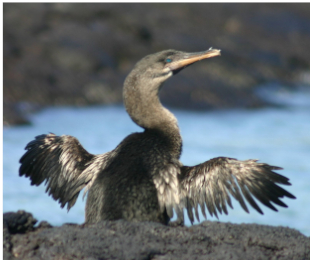The Galapagos Cormorant
Genesis 1:20
“And God said, Let the waters bring forth abundantly the moving creature that hath life, and fowl that may fly above the earth in the open firmament of heaven.”
 The Galapagos Cormorant cannot fly. Its wings are too small. Despite this, it seems to survive admirably, feeding on fish, small octopuses, and other seafood.
The Galapagos Cormorant cannot fly. Its wings are too small. Despite this, it seems to survive admirably, feeding on fish, small octopuses, and other seafood.
The flora and fauna of the Galapagos are forever associated in the minds of many with Charles Darwin during his famous voyage around the world on board the Beagle. For that reason, it is not surprising to read this on Wikipedia:
These cormorants evolved on an island habitat that was free of predators. Having no enemies, taking its food primarily through diving along the food-rich shorelines, and not needing to travel to breeding grounds, the bird eventually became flightless. Indeed, wings trapping air among flight feathers are likely to have been a disadvantage to the cormorants which dive from the surface.
But how could the “evolution” of its tiny wings be of such advantage to the cormorant? There are many other sea birds living, nesting, and feeding in the same area, and evolution has not seen fit to reduce their wings.
There is, as always, a much better, more scientific explanation. The cormorants’ wings are mal-formed. Dr. Vij Sodera says, “The most plausible explanation is that a deleterious mutation has been inbred and caused the original Galapagos cormorants to become flightless.” With the lack of predators, the deformed birds have survived. It is likely that many of the world’s flightless birds have not evolved flightlessness but are an unfortunate function of the decay caused by the Fall of Adam.
Prayer: Father, we are amazed at the wealth and variety of wildlife all over this world, and we praise Your Name. Amen.
Author Paul F. Taylor
Ref: Sodera, V. (Second Edition: 2009), One Small Speck to Man (London: Viija Sodera Productions), pp. 153-155. Image: CC BY-SA 3.0 Unported.
© 2021 Creation Moments. All rights reserved.